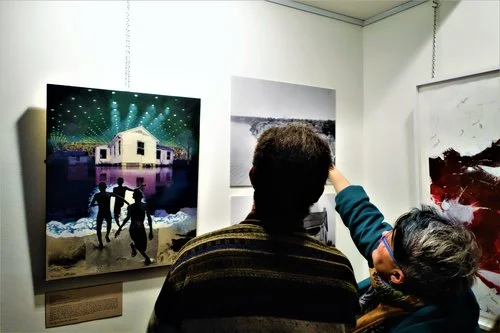Christina Battle, William “Billy” Beal, Anna Binta Diallo, Cheryl Foggo, Judah Iyunade, Richard Allan Thomas, Chukwudubem Ukaigwe, NASRA, Frank B. Jamerson fonds.
Curated by Alyssa Camille Fearon
BLACK PRAIRIES honors more than one hundred years of Black/African-Canadian cultural production in the Prairies, spanning the 1920s to the present, with a focus on lens-based media. The exhibition includes newly commissioned contemporary artwork, original glass plate negatives by early 1900s Black Manitoban photographer William “Billy” Beal, and archival photographs from the City of Edmonton’s Frank B. Jamerson fonds.
Beal’s glass plate negatives, taken between 1915 and 1925, document homesteading life in western Manitoba from the perspective of a lone Black man living in an all-white rural township during the early 20th century. Meanwhile, the photographs in the Frank B. Jamerson fonds, created by unnamed photographers, depict everyday Black life in and around Amber Valley, Alberta—a historic community formed during the Great Black Migration of 1910. This migration saw African-Americans fleeing racial violence in the United States to seek refuge in the Canadian Prairies. The selected photographs in this exhibition capture the first thirty years after the migration, reflecting the experiences of the first generation of Black migrants in the region. The contemporary artists in this exhibition foster important dialogues about personal histories, a changing climate, and collective experiences in the region.
Additionally, the exhibition includes the newly created short film For Caesar by filmmaker Cheryl Foggo. The film features Leander Lane, the great-grandson of Julius Caesar Lane, a founding member of the Shiloh People, the historic African-Canadian community in Saskatchewan.
BLACK PRAIRIES provides space for communal grounding and reflection on the ongoing and ever-expanding continuum of Black life and Black cultural production in the Prairies.
Touring Locations (dates TBD):
University of Calgary Nickle Galleries, Calgary, AB
University of Lethbridge Art Gallery, Lethbridge, AB
Moose Jaw Museum and Art Gallery, Moose Jaw, SK
PLATFORM, Winnipeg, MB
Image: Plate 42: William S.A. Beal, self-portrait, Big Woody district, Swan River, Manitoba. c. 1918. (William S.A. Beal/Image courtesy of R. Barrow)
























